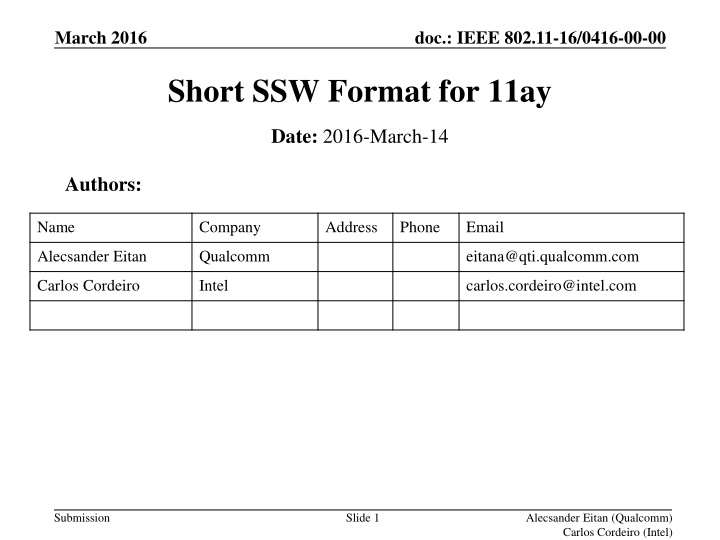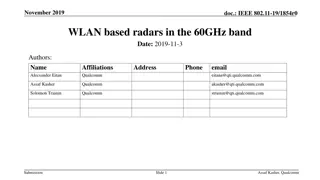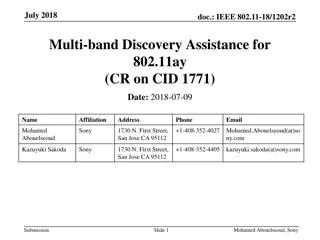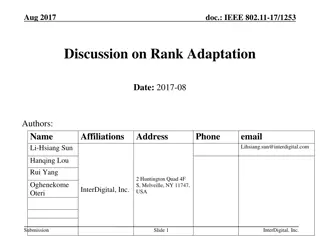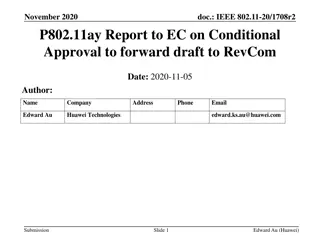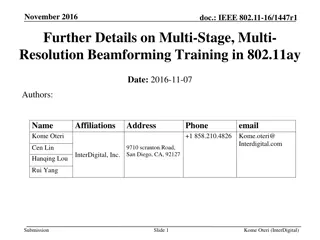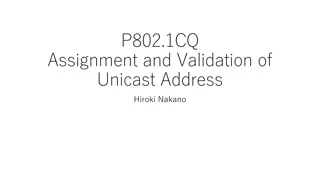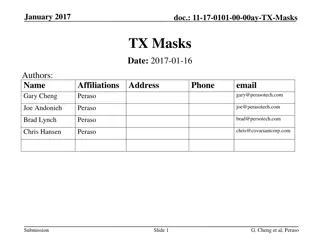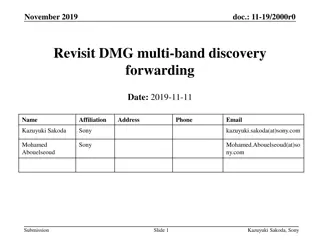IEEE 802.11-16/0416-00-00 Short SSW Format for 11ay
This document discusses the need for supporting massive arrays in the IEEE 802.11 standard, focusing on reducing the time required for Sector Sweep (SSW) in the context of mmWave communication. It emphasizes the use of high-gain antennas and the challenges of implementing massive arrays efficiently. The content covers the existing SSW frame format, time analysis, and the impact on AP and STA interactions.
Download Presentation

Please find below an Image/Link to download the presentation.
The content on the website is provided AS IS for your information and personal use only. It may not be sold, licensed, or shared on other websites without obtaining consent from the author.If you encounter any issues during the download, it is possible that the publisher has removed the file from their server.
You are allowed to download the files provided on this website for personal or commercial use, subject to the condition that they are used lawfully. All files are the property of their respective owners.
The content on the website is provided AS IS for your information and personal use only. It may not be sold, licensed, or shared on other websites without obtaining consent from the author.
E N D
Presentation Transcript
March 2016 doc.: IEEE 802.11-16/0416-00-00 Short SSW Format for 11ay Date: 2016-March-14 Authors: Name Company Address Phone Email Alecsander Eitan Qualcomm eitana@qti.qualcomm.com Carlos Cordeiro Intel carlos.cordeiro@intel.com Submission Slide 1 Alecsander Eitan (Qualcomm) Carlos Cordeiro (Intel)
March 2016 doc.: IEEE 802.11-16/0416-00-00 Preface In mmWave path-loss is large and the main method to overcome it is by using high gain antennas. These are practical due to the very short wavelength. Massive arrays provide excellent coverage while AP form factor has infinite footprint availability for these arrays. Mobile form factor dictates small arrays. In outdoor, massive arrays are expected. Submission Slide 2 Alecsander Eitan (Qualcomm) Carlos Cordeiro (Intel)
March 2016 doc.: IEEE 802.11-16/0416-00-00 Motivation The standard needs to support massive arrays. Massive array achieves high gain with narrow beam which requires much more sectors to be used for training/access. Example: Massive array with 256 antennas uses 256 sectors. Each sector is ~4 degrees wide. 256 sectors require at least 4 ms for initial sector sweep. SSW is a basic mandatory flow that is essential for reliable link. We want to reduce the massive array SSW time by shortening the SSW duration. We prefer changes which minimize impact to existing software and hardware. Submission Slide 3 Alecsander Eitan (Qualcomm) Carlos Cordeiro (Intel)
March 2016 doc.: IEEE 802.11-16/0416-00-00 Existing Frames: Sector Sweep (SSW) Time Analysis SSW frame is defined at 8.3.1.16 in 802.11ad. Overall 26 bytes in each SSW frame. Must be transmitted in CP in order to be received by the non-directed receiver. Frame Control Duration RA TA SSW SSW Feedback FCS Octets: 2 2 6 6 3 3 4 * SSW frame format(11ad) B0 B1 B9 B10 B15 B16 B17 B18 B23 Direction CDOWN Sector ID DMG Antenna ID RXSS Length Bits: 1 9 6 2 6 * SSW field format(11ad) Submission 4 Alecsander Eitan (Qualcomm) Carlos Cordeiro (Intel)
March 2016 doc.: IEEE 802.11-16/0416-00-00 Existing Frames: Sector Sweep (SSW) Time Analysis (cont.) 63% of the scan time is spent on transmissions of the 26 bytes SSW frames and the corresponding parity check bits. 31% of the scan time is spent on preambles + PHY headers. 6% of the scan time is spent on BIFSs. In case of multiple DMG antennas, the percentage is slightly higher due to LBIFS instead of SBIFS. SSW duration is Nsectors*15.8us. Samples Time [us] 7296 1280 6656 10752 Preambles 57 x G_128 Header 5 Bytes Payload 26 Bytes Parity 2 codewords BIFS Total 4.15 0.73 3.78 6.11 1.00 15.76 1 Nsectors 32 64 128 256 512 SSW time [ms] 0.5 1.0 2.0 4.0 8.1 Submission 5 Alecsander Eitan (Qualcomm) Carlos Cordeiro (Intel)
March 2016 doc.: IEEE 802.11-16/0416-00-00 Existing Frames: Sector Sweep (SSW) Time Analysis (cont.) When the AP is the initiator and an associated STA is the responder Several fields can be either compressed or removed This is the most common scenario for the SSW. Long time for massive array AP Use of shorten SSW frame is optional (only when the two sides are supporting it). Submission 6 Alecsander Eitan (Qualcomm) Carlos Cordeiro (Intel)
March 2016 doc.: IEEE 802.11-16/0416-00-00 Requirements for Short SSW An EDMG STA can transmit Short SSW packets to a peer STA only after, at a minimum, it discovers that the peer STA is also an EDMG STA Knowledge of MAC addresses and possibly STA capability required beforehand A MAC rule is required to this effect The total number of bytes for the MAC payload of the Short SSW packet needs to stay <= 6 bytes A legacy DMG STA shall be able to set CCA busy for the duration of the Short SSW packet by PLCP header detection Initiator needs to be able to indicate to any recipient EDMG STA that the packet is a Short SSW packet To keep it short, SLS using Short SSW packet uses DMG Control PHY and not EDMG Control PHY Submission Slide 7 Alecsander Eitan (Qualcomm) Carlos Cordeiro (Intel)
March 2016 doc.: IEEE 802.11-16/0416-00-00 Short SSW format proposal Proposed Short SSW packet 11ad SSW frame Packet Type Addressing CDOWN RF Chain ID Short SSW Feedback Direction Reserved FCS Frame Control Duration RA TA SSW SSW Feedback FCS Bits: 16 16 48 48 24 24 32 Bits: 2 16 11 2 11 1 1 4 6 octets 26 octets Field Definition Packet Type Indicates the type of the packet. Possible values: 0: Short SSW, 1-3: Reserved Addressing The format is TBD. CDOWN A down-counter indicating the number of remaining Short SSW packet transmissions and LBIFSs to the end of the TXSS/RXSS across all antennas. This field is set to 0 in the last Short SSW packet transmission. RF Chain ID Identifies the RF chain the transmitter is currently using for this transmission. Short SSW Feedback In a RSS, contains the value of the CDOWN field of the Short SSW packet that was received with best quality in the immediately preceding sector sweep. The determination of which packet was received with best quality is implementation dependent. This field is reserved when transmitted as part of an ISS. Direction Indicates the direction of the transmission. The Direction field is set to 0 to indicate that the frame is transmitted by the beamforming initiator and set to 1 to indicate that the frame is transmitted by the beamforming responder. FCS The four MSBs of the FCS Submission Slide 8 Alecsander Eitan (Qualcomm) Carlos Cordeiro (Intel)
March 2016 doc.: IEEE 802.11-16/0416-00-00 Details of proposed format Short SSW is a PHY packet (similar to 11n/ac NDP), not a MAC frame For this format, the Length field in the PLCP Header is set to 6. Therefore: A legacy DMG STA drops the packet since this is an invalid length, and keeps CCA busy until the end of packet A third party EDMG STA computes the ISS/RSS duration through the CDOWN field and sets the NAV for this duration Packet Type field allows for future packets to be defined and that use the same approach Short SSW Feedback field allows using the Short SSW for ISS and RSS Support of up to 2048 sectors Hash function for Addressing field is TBD. Short SSW duration is 9.6usec (including the BIFS) (saves 37.8%) For EDMG STAs, define LBIFS as equal to: 2*TXTIME(Short SSW)+2*SBIFS Submission Slide 9 Alecsander Eitan (Qualcomm) Carlos Cordeiro (Intel)
March 2016 doc.: IEEE 802.11-16/0416-00-00 Summary The standard needs to support massive arrays with many sectors. The SLS overall duration scales with the number of sectors. We suggest to reduce the SLS duration by shortening the SSW duration. We suggest to add a Short SSW Format to 11ay to be used EDMG STAs reducing the transmission duration to 9.8usec (37.8% saving) Suggested format supports ISS and RSS up to 2048 sectors We also suggest to set the LBIFS to be same as duration of two Short-SSW and keep the counting CDOWN during this period. Submission Slide 10 Alecsander Eitan (Qualcomm) Carlos Cordeiro (Intel)
March 2016 doc.: IEEE 802.11-16/0416-00-00 Motion 7.6 EDMG Beamforming Insert the following in section 7 of the SFD: The format of the Short SSW packet is defined in <slide 5>. An EDMG STA shall not transmit a Short SSW packet to another STA that is not also an EDMG STA. Insert the following in section 4.2 of the SFD: For SLS using Short SSW frames, LBIFS is equal to 2*TXTIME(Short SSW) + 2*SBIFS. An EDMG STA performing an SLS using Short SSW frames shall increase the value of the CDOWN field within the Short SSW frame by two for each LBIFS contained as part of a sector sweep. Submission Slide 11 Alecsander Eitan (Qualcomm) Carlos Cordeiro (Intel)
